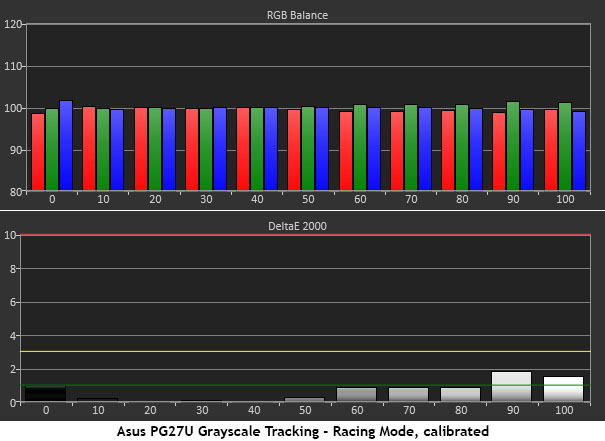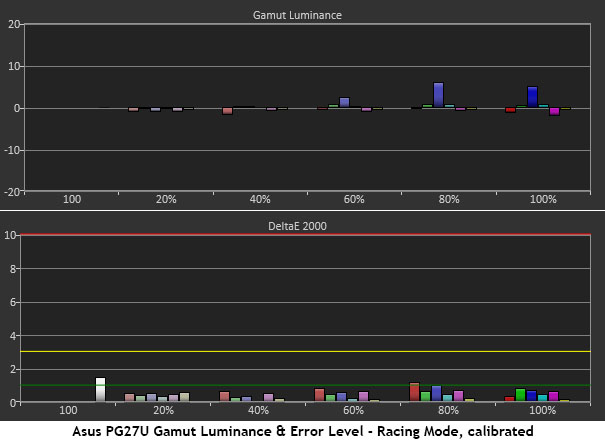Asus ROG Swift PG27UQ 4K Gaming Monitor Review: Worth Every Penny
The Asus ROG Swift PG27UQ is one of the best (and priciest) 4K gaming monitors around.
Why you can trust Tom's Hardware
Grayscale, Gamma & Color
The PG27UQ includes a factory-certified calibration for its Racing image mode. We measured that, as well as the sRGB mode before calibrating the white point.
Grayscale Tracking
We describe our grayscale and gamma tests in detail here.


If you leave the PG27UQ at its default settings, it doesn’t require a calibration. The sRGB preset measured identically to Racing, so we didn’t include that chart. For us, grayscale tracking here ran ever-so-slightly blue from 70-100 percent. This is a barely visible error that few people will see apart from a test pattern.
Calibration produced pro-level performance with all but two brightness steps under 1dE (green horizontal line). It doesn’t get much better; this qualifies the PG27UQ for professional use.
Comparisons


A grayscale error of 3dE puts the PG27UQ right in the middle of the pack. This is average performance, even among premium gaming monitors. You won’t need to calibrate, but there is some room for improvement.
After calibrating to 200 nits brightness,, the PG27UQ was bested only by the LG 34WK650. However, an average error of .69dE is still among the lowest we’ve recorded for any monitor.
Gamma Response


The only gamma adjustments available are five accurately labeled presets. We stuck with 2.2 for our SDR tests.
Get Tom's Hardware's best news and in-depth reviews, straight to your inbox.
As you can see, calibration made no difference here. The dip at 10 percent is not visible in actual content, nor does it affect color tracking. This is excellent performance.
Comparisons


Both the gamma value range and average gamma deviation tests were spoiled slightly by that dip at 10 percent, But we have no complaints. The PG27UQ tracked luminance almost perfectly in Racing and sRGB modes.
Color Gamut & Luminance
For SDR content, we measured the sRGB gamut. The PG27UQ covers over 90 percent of the DCI-P3 color gamut, but we left that to the HDR tests, which you’ll find on page five.
For details on our color gamut testing and volume calculations, click here.




There is little to see here except accurate color and luminance tracking. Saturation points were on-target, and luminance levels were neutral except for a slight rise in the blue primary. Our grayscale calibration took the measured error from an average of 1.78dE to .56dE. Again, this is pro-level performance and easily qualifies the PG27UQ for color-critical tasks.
Comparisons


We haven’t measured many professional monitors that can render color this accurately. The PG27UQ may be a gaming monitor but it can easily be used in a video post-production setting. Along with a super low .56dE average color error, it managed to cover just over 90 percent of DCI-P3. No displays we’ve reviewed can cover more (nor can any televisions we’re aware of currently).. As you’re about to see, this premium performance extends to HDR mode.
MORE: Best Gaming Monitors
MORE: How We Test Monitors
MORE: All Monitor Content
Current page: Grayscale, Gamma & Color
Prev Page Brightness & Contrast Next Page HDR Grayscale, EOTF & Color
Christian Eberle is a Contributing Editor for Tom's Hardware US. He's a veteran reviewer of A/V equipment, specializing in monitors. Christian began his obsession with tech when he built his first PC in 1991, a 286 running DOS 3.0 at a blazing 12MHz. In 2006, he undertook training from the Imaging Science Foundation in video calibration and testing and thus started a passion for precise imaging that persists to this day. He is also a professional musician with a degree from the New England Conservatory as a classical bassoonist which he used to good effect as a performer with the West Point Army Band from 1987 to 2013. He enjoys watching movies and listening to high-end audio in his custom-built home theater and can be seen riding trails near his home on a race-ready ICE VTX recumbent trike. Christian enjoys the endless summer in Florida where he lives with his wife and Chihuahua and plays with orchestras around the state.
-
mlee 2500 Won't catch me buying a monitor with a fan inside. I don't care how great it is otherwise. Not too mention 4K at 27" is kind of a pointless waste of the GPU resources you use to drive it. Even at 28" I find my XB280HK too small for most games at 4K...it just makes all the hours that game developers and artists put into their product become pointless when the details are too small to notice.Reply
I've come to the conclusion that 30" is probably the sweet spot of not extending too far beyond your peripheral vision while still being large enough to make 4K worthwhile (I had a 31" LG and it was *too* big, IMHO). Of course this all assumes a rational 16:9 aspect ration. Don't even get me started on these super wide models with a paltry 1440 vertical. Seems like a neck injury waiting to happen. -
milkod2001 This is something i was waiting for ages. Just one thing. I'm not 13years old any more, wish i was :). I don't need that stupid holographic or RGB lighting at the back. Just regular adjustable stand. I also don't need HDR, it's immature gimmick at the moment. I also want 32'' 4k version. 27''4k is a joke. Also price should be more down to earth $1200-1500. Gonna wait a little bit more i guess.Reply -
milkod2001 Go ahead and read reviews of actual owners on newegg. There is a loud fan included. This is not acceptable at this price.Reply -
moogleslam @Joe Black - I wouldn't call that the best thing about it, but sure, there isn't much need for a 16:9 27" to be curved. Not sure if you're against curved in general, but there's absolutely a place for it. a 21:9 34" or a 32:9 49" absolutely has to be curved.Reply